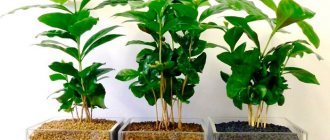The coffee tree is an exotic plant that decorates the apartment with an original, unusual appearance and fills it with a rich aroma. Caring for a coffee tree at home is not difficult, but requires knowledge of the peculiarities of its agricultural technology. For proper care, the evergreen plant will “repay” with lush, fragrant inflorescences and bright berries, from the grains of which you can prepare a natural, tonic drink.
What soil is needed for an Arabica coffee tree? Conditions and care
How to care for a coffee tree.
Like any southern tree, coffee prefers soft but bright diffused light (not direct sunlight!), room temperature 18-22°C and regular ventilation (not drafts!) with warm air. The soil for the coffee tree is heavy and acidic (pH no more than 5.5). You can prepare it yourself by taking leaf soil, greenhouse soil, and sand in a ratio of 1:1:1:2:1, or purchase ready-made PETER PEAT soil with an acidic reaction “Azalea. Hydrangea. Rhododendron" line HOBBY. The presence of chopped sphagnum moss in the soil (for example, “Sphagnum Moss” from the VITA line) will not hurt: it will maintain its acidity and perfectly retain moisture. The root system of the coffee tree is extensive and deep, so you will need a large and high planting container, as well as drainage from expanded clay from the VITA line or pebbles from the DECO line.
Watering
Water the tree only with settled, soft and slightly warmed water. From March to October, when the tree is actively growing and blooming, provide it with abundant watering, making sure that water does not accumulate in the pan and the roots do not rot. From November to February, the coffee tree is dormant and can be watered only after the surface layer of soil has dried.
Feed your pet with liquid humic fertilizer PETER PEAT “Living Force: for indoor plants” from April to September once every 2 weeks. When caring for it, do not “circle” or rearrange it, trying to achieve uniform illumination - the tree will shed its leaves and stop blooming. Transplantation and a new pot will be required annually (March-April), until the coffee tree reaches three years, and then every 2 years.
Trimming
The plant should be pruned as needed. Remove leaves and stems if they dry out. Form the crown by cutting off overgrown branches and giving them the required length.
Watering
A tropical plant requires frequent moistening of the earthen clod, but stagnation of water should not be allowed, as this threatens rotting of the roots. Large leaf plates evaporate a lot of moisture, but the coffee tree has not adapted to accumulate it “for a rainy day,” so watering is needed frequently, but not too much.
If the soil is selected correctly and the drainage is well organized, then after watering water will flow into the pan - it needs to be drained. The higher the air temperature, the faster the top layer of soil dries out; watering should focus on this.
The water should be no cooler than the air, so you need to monitor its temperature. But it’s even more important to monitor water quality. It should be clean and soft, without limestone impurities (they can destroy the roots); you can add a little citric acid or vinegar to it.
Liquid fertilizing with mineral fertilizers is usually combined with watering.
Feeding is done no more often than every two weeks and no less than every six weeks. They can be alternated and diversified, so in the spring they give more nitrogen, and before flowering the dose of phosphorus and potassium is increased. You can add bone meal to the top layer of soil.
Soil for coffee trees at home. Preparing the soil for cultivation
Coffee loves acidic soils, which corresponds to the conditions of its homeland. The pH level for coffee should be between 4.5 and 5.5. At the same time, some gardeners recommend using soils for azaleas, hydrangeas or rhododendrons for coffee trees at home. However, you should pay attention to the acidity level.
If it is slightly higher than recommended (for example, soil pH for azaleas is 4.0), it can be used to grow a coffee tree, but if the soil is highly acidic (pH = 3.5), then it is better not to do this.
Fruiting coffee tree (Arabica), grown at home
Sometimes inexperienced gardeners purchase soil suitable for growing citrus fruits for a coffee tree. It is only partially suitable for the coffee tree, since its composition is acceptable, but it is more neutral than slightly acidic. You also need to know that approximately six months to a year after the start of active growing season, the soil under the coffee tree changes its composition and ceases to be acidic, shifting to neutral acidity.
In both of the considered cases, to ensure a normal acidity level for coffee, it is recommended to “acidify” the soil once a month. This is best done with lemon juice in a concentration of 3-4 drops per 1 liter of water. If you don’t have lemon on hand, you can use citric acid (2-3 grains per 1 liter of water).
The roots of the coffee tree are quite long, penetrating deeply into the soil. To ensure they have adequate supply of nutrients and air, it is necessary to use well-drained and loose compounds. The matted soil must be loosened and humus or peat added to it (depending on the acidity).
You can prepare the soil yourself. For this you will need:
- turf soil – 1 part
- leaf soil - 1 part
- humus - 1 part
- coarse river sand – 1 part
- peat – 2 parts
Sometimes it is recommended to add 0.5 parts of sphagnum moss to this composition for greater looseness.
Diseases and pests
The coffee tree gets sick occasionally. The main reason can only be incorrect care. Pests, attacking this plant at one moment, can completely kill it in a short time. If they are seen at the right time, the tree can be saved. Well, diseases, if identified in time, are not scary:
- If you notice that the leaves have begun to turn yellow, spin, their number has sharply decreased, or spots have appeared on the surface, the reason is unfavorable living conditions. In this case, all warped branches are cut off, and a painstaking check of the soil and root system is carried out.
- If rottenness is detected, proof of a suspicion of a fungal disease, all unhealthy shoots are cut off from the root with a knife, and then the sections are sprinkled with charcoal. The leaves are treated with products suitable for combating rot. After drying, the plant is planted in new soil.
- The whitefly likes to parasitize plants. It's impossible not to see her. A whitish coating similar to a network appears on the leaves. If you don’t start fighting the pest right away, the tree cannot be saved. Soapy water will help in the fight.
- Often the tree is affected by powdery mildew and scale insects. It will not be easy for the owner of the plant to cope with these parasites. Special care is needed here. Alcohol, Karbofos or Actellik should be on hand just in case.
What soil is needed for a coffee tree? Where can I get a coffee tree seedling?
The first option is that a coffee tree can be grown from a grain (seed). Yes, in fact, coffee beans can be grown, but not from what is sold in stores. It is impossible to grow a coffee tree from the coffee beans we are used to, even if they are not roasted. To do this, you need to purchase special coffee tree seeds, these are sold in specialized garden stores. But when growing coffee from seeds, you will have to wait a very long time for the first flowering and fruiting.
The best option would be to purchase a rooted cutting from a coffee tree. Coffee cuttings are not expensive and fruiting can be achieved after only a year of cultivation. You can buy rooted coffee cuttings in nurseries (exotic plant stores) or from amateur collectors (such sales advertisements are usually posted on social networks and forums); when buying a plant on free classifieds sites (Ebay, Avito, OLX), they can very often deceive and sell the wrong thing, it is better to refrain from such purchases.
We bought a coffee tree seedling – what to do?
You bought a small coffee tree seedling, brought it home, and what to do next? The first step is to transplant the seedling from the shipping container into a permanent pot. Usually, during mass propagation and cultivation, inexpensive, square containers are used, which are filled with special soil to accelerate the growth of the plant’s root system. Such pots and soil are great for greenhouses, but are completely unsuitable for apartment window sills, they are not beautiful, and the soil in such pots dries out very quickly, which can lead to the death of the coffee tree. That's why a transplant is necessary.
Growing coffee from beans
It will take longer to successfully grow a coffee tree from beans. Coffee beans, which are sold in stores and coffee shops for preparing the drink, are not suitable for sowing. Even if it is green coffee, the beans have been minimally processed and not picked soon. For planting, you need to buy fresh, unprocessed grain. The period from seed collection to sowing should not exceed 45 days.
You can buy high-quality planting material in specialized stores. An alternative is to plant fresh coffee berries or beans from such berries. This is the best option if it is possible to get the fruit directly from the tree.
Grain from the store must first be soaked in a solution of a complex growth stimulator, in a slightly pink solution of potassium permanganate or in plain water. To speed up seed germination, you can carefully cut the dense shell with a knife before soaking.
Planting is carried out in the following order:
- place the grain in prepared and moistened soil to a depth of 1.5 - 2 cm with the flat surface down;
- sprinkle earth on top;
- watered;
- cover with a glass jar or a layer of polyethylene.
The cover is removed as the first leaves are released from the membrane. Planting a whole berry or seed, separated from the pulp immediately before starting work, follows the same procedure without preliminary soaking.
Grains germinate 30–90 days after sowing. When planting whole berries, this period extends to six months. The first flowers on a coffee tree grown from seed can be expected after 3 to 4 years.
Arabica coffee soil. Special soil for coffee tree
Coffee trees are very heat-loving plants. This is why ordinary soil is not at all suitable for a coffee tree. Growing a coffee tree at home is not at all difficult. The most important thing is to be patient.
The coffee tree begins to bear fruit in the third year, and the maximum yield is obtained after six to seven years.
Growing a tree from grain
An exotic plant like a coffee tree can be grown in two ways. The first of them is cuttings. If you have the opportunity to buy or get a cutting of such a wonderful plant somewhere, it is best to use this method. The fact is that the cutting will grow much faster than the shoot from the grain. And they develop fully, in breadth (in a bush), while the grain can stretch into a long bare (without leaves) stem.
The most suitable varieties for growing indoors are Arabian (arabika) and dwarf Nana (dad).
However, growing a coffee tree at home from a grain is much more interesting. There is nothing tricky or complicated in this process. Even regular unroasted coffee beans bought in a store are suitable for growing. Before putting a coffee bean into the ground, it is necessary to carry out pre-planting preparation. In order for the grain to germinate accurately, the hard outer shell must be slightly disturbed (sawed, broken or cut). Such delicate work may require some experience, but you can do without it. It is also necessary to soak the grains in a solution of stimulants, for example, Heteroauxin or Epin.
Return to contents
Ground and air
Planting coffee is not at all difficult, but the soil for such an outlandish plant must be special. The soil for growing coffee at home must be acidic, otherwise the grain will not be able to germinate. Of course, a beginner, and sometimes even a fairly experienced gardener, cannot accurately determine the acidity of the soil, which is why it is best to make your own composition:
The optimal temperature for growing a coffee tree at home is 22-25°.
- 20% river sand;
- 40% turf land;
- 30% leaf soil;
- 10% high peat.
Arabica trees grow just perfectly in such soil. However, in addition to the soil, special attention should be paid to air humidity.
It must be maintained, and standard spraying is not always enough. To solve this problem, you need to place the pot with the plant on a tray with small pebbles or expanded clay and pour water into it.
But even after this, the plant should be sprayed periodically.
Return to contents
Required lighting
Proper lighting for exotic plants is no less important than good soil. Of course, this plant does not make any special requirements. It loves light and warmth, but at the same time, excess sunlight can have a detrimental effect on the development of the sprout.
The most common mistake when growing a coffee tree is exposing the plant to direct sunlight.
The ideal place to place a pot with a coffee sprout would be the southeast or southwest. On the north side, coffee will also grow, but due to the lack of warm sunlight, its formation will be slower.
As mentioned above, excess sun can be harmful, but this applies mostly to young, not yet fully formed plants. In order for the coffee sprout to be healthy and develop well, it should not be exposed to direct sunlight.
As for adult plants, they simply need the sun to form inflorescences.
Return to contents
Transplanting and watering
In order for a coffee tree to grow and develop, it, like other house plants, must be replanted periodically. Young coffee cuttings are replanted every year. But adult fruit-bearing plants can be replanted no more than once every three to four years.
Water the plant with soft, settled water.
Before replanting begins, drainage must be placed at the bottom of the new pot. In addition, you should carefully examine the root system, removing diseased or rotten roots.
As for watering, it should be plentiful in the summer, but moderate in the winter. In order to correctly calculate the frequency of irrigation, it is necessary to take into account the temperature in the room where the coffee is grown. The soil for the coffee tree should always remain moist. In this case, you should avoid overmoistening and, of course, overdrying. It is better to water and spray a young coffee tree with soft water. Melt and rain liquid are most suitable for these purposes.
Some people believe that since coffee comes from the tropics, it needs the rays of the scorching sun all year round. This conclusion is fundamentally incorrect. Even on huge plantations in the tropics, other plants are planted around one coffee seedling for shading. Therefore, even in our conditions, it is impossible to leave a coffee sprout in open sunlight for a long time.
In cold weather, such exotic plants should be kept warm at a temperature of at least 18°C.
So that the plant does not need sunlight in winter, it must be illuminated with a fluorescent lamp.
What soil for a coffee tree. Soil/soil for coffee tree
What kind of land is needed for coffee? (compound)
The following soil composition has proven itself well:
- Turf land - 40%;
- Leaf soil - 30%;
- Sand - 20%;
- Peat - 10%.
For seedlings up to 4 years old, the following soil composition may still be suitable: turf soil, sand, leaf soil in a ratio of 1:1:2. Such plants are replanted once a year.
For adult plants (5 - 10 years old), they also take turf soil, humus, leaf soil, sand in a ratio of 2: 1: 3: 0.5. This soil mixture is also suitable for older plants. They are replanted once every 3-5 years.
It is recommended to add sphagnum moss to the soil mixture. It will enrich the soil very well, provide it with acidity and maintain moisture.
In the photo below you will see what the components that make up the mixture look like:
Sod land
Leaf ground
Peat land
Method of preparing the mixture
The soil mixture should be prepared in advance. Experienced gardeners prepare the soil 2 weeks before transplanting so that it can settle. Disinfection by steaming or piercing in the oven is recommended.
If it is not possible to make a similar soil composition, then choose any Universal soil. A soil mixture for azaleas is even better; it also has an acidity pH of 4.5-5.5.
To it you need to add 25% sand and a little coal chips. To do this, you can use several tablets of activated carbon.
There is information that a young cutting of a coffee tree grows very well in a mixture of peat and perlite (this is a type of construction sand) in a 1:1 ratio. When planting, this mixture should be treated with a weak solution of potassium permanganate.
Attention! When planting, do not compact the soil! The soil should be light, loose, soft and not dry.
Enrichment of soil with mineral fertilizers
Also, once a month the soil is fertilized with mineral fertilizers. The most suitable fertilizer for flowering plants or roses.
Therefore, 2 - 3 times a month, the water for irrigation needs to be acidified (2 - 3 drops of lemon juice per 1 liter of water).
It is very important to remember about drainage in order to prevent excess moisture in the soil.
It is important to know that with a neutral or alkaline soil reaction, the absorption of nutrients by the plant slows down. The development of the tree will be delayed, the leaves may turn black (necrosis will occur), and the tree will not bloom.
What kind of pot is needed for a coffee tree. Temperature and Lighting for Growing Coffee Trees
Coffee is a southern resident, but direct sunlight is contraindicated for it. Otherwise, the beautiful shiny leaves may suffer, their edges will dry out and the plant will lose its decorative effect. The following conditions are considered optimal: Abundant diffused lighting (eastern or western window). When placed on the south, southeast or southwest side, shading is required during the midday hours in summer and early spring. Fresh air and regular ventilation. No drafts - air flows during ventilation should not hit the coffee tree. Keep in the spring-summer period at a temperature of 22-26°C. Temperature drop in winter to 16-18°C.
Temperatures below 15°C will cause the plant to shed buds and leaves, and air colder than 12°C can be detrimental to the tree. During the heating season, the flower pot should not be located near heating devices. The coffee tree can be located on the north side, but in this case the growth process will be delayed, and it will not be possible to wait for flowering, especially beans, without sufficient sunlight.
Spraying
Oddly enough, the tropical Arabica tree does not need a high level of humidity at all, but it gratefully accepts spraying of its large beautiful leaves. Only the water for spraying must be taken a degree - one and a half warmer than the surrounding air and, of course, it must be settled and not have any impurities.
Caring for an Arabica coffee tree is not difficult, the main thing is not to forget to monitor the level of soil acidity - as it decreases, the leaves will begin to turn pale, yellow and dry. They will dry out even without fresh air, but the tree must be protected from drafts or directed air flows. Too high air humidity can cause the leaves to rot; this should not be allowed. This tree also does not like being pruned and moved from place to place. Therefore, you need to think about the formation of the crown from the very beginning - it is better to pinch the sprout than to cut off the shoot later.
Soil for coffee tree. Types of coffee trees
The Arabian coffee variety, popular for growing at home, is a compact tree. The leaves are shaped like an elongated ellipse with a dark olive tint, glossy on the outside and pale on the inside. The inflorescences are small, about 2 centimeters in diameter, collected in a bouquet. The size of the inflorescences directly depends on the growing conditions.
Once opened, flowers remain fresh for only a few hours. But the buds gradually open, not all at once. After the inflorescences fade, the fruit ripens in the form of a berry; when ripe it has a burgundy hue. Ripening occurs approximately 8 months after pollination. The paired fruits resemble round beans. This species reaches a height of up to 5 meters.
Coffee dwarf Nana is a neat plant, reaching a height of about 85 cm. It blooms profusely and subsequently bears fruit well at home. The tree can be given the desired design by trimming and pinching the tops of the plant.
Liberian coffee is also grown indoors. Its ripe fruits have a scarlet or sunny slightly orange tint. The length of its leaves reaches up to 40 cm, and the height is adjusted and the required shape is formed by trimming the crown of the plant. The inflorescence has a light shade and large fruits - berries.
Peculiarities
An evergreen plant, the coffee tree (or sometimes a shrub) is native to the tropics. Arabica or Arabian coffee tree prefers highlands, volcanic plateaus, rocky terrain; an adult tree produces 5 kg of fruit per year, that is, approximately 1 kg of coffee beans. The Arabica coffee indoor plant feels great in a pot; it can be grown as a bush or formed into a tree up to one and a half meters tall. If comfortable conditions have been created for him and he is completely satisfied with the care, then an adult plant can give 0.5 kg of fruit. This, of course, is not very much, but a home plant is grown not only for harvest.
The roots of the coffee tree do not grow too large, so it can feel quite comfortable in a pot. The branches are flexible and long, they do not branch too much, so they usually work on the crown. The thick crown formed by dark green glossy oval leaves looks very decorative. The leaves are quite large, pointed at the end, slightly corrugated at the edges, with clearly visible veins. The white flowers are small, resemble jasmine flowers in appearance, collected in inflorescences of 3-6 pieces, usually bloom in spring. After self-pollination, small green fruits are formed; during the ripening process, which lasts more than six months, they acquire a red color. Each fruit contains two seeds. If properly cared for, the plant can travel this entire path at home.











